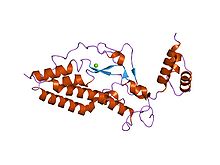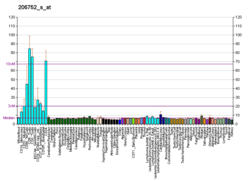DFFB
| DNA fragmentation factor 40 kDa | |||||||||
|---|---|---|---|---|---|---|---|---|---|

crystal structure of caspase-activated dnase (cad)
|
|||||||||
| Identifiers | |||||||||
| Symbol | DFF40 | ||||||||
| Pfam | PF09230 | ||||||||
| InterPro | IPR015311 | ||||||||
| SCOP | 1v0d | ||||||||
| SUPERFAMILY | 1v0d | ||||||||
|
|||||||||
| Available protein structures: | |
|---|---|
| Pfam | structures |
| PDB | RCSB PDB; PDBe; PDBj |
| PDBsum | structure summary |
NP_001269598
NP_001307061
NP_001307065
NP_004393
Caspase-Activated DNase (CAD) or DNA fragmentation factor subunit beta is a protein that in humans is encoded by the DFFB gene. It breaks up the DNA during apoptosis and promotes cell differentiation. It is usually an inactive monomer inhibited by ICAD. This is cleaved before dimerization.
Apoptosis is a cell death process that removes toxic and/or useless cells during mammalian development. The apoptotic process is accompanied by shrinkage and fragmentation of the cells and nuclei and degradation of the chromosomal DNA into nucleosomal units. DNA fragmentation factor (DFF) is a heterodimeric protein of 40-kD (DFFB) and 45-kD (DFFA) subunits. DFFA is the substrate for caspase-3 and triggers DNA fragmentation during apoptosis. DFF becomes activated when DFFA is cleaved by caspase-3. The cleaved fragments of DFFA dissociate from DFFB, the active component of DFF. DFFB has been found to trigger both DNA fragmentation and chromatin condensation during apoptosis. Multiple alternatively spliced transcript variants encoding distinct isoforms have been found for this gene, but the biological validity of some variants has not been determined.
...
Wikipedia






